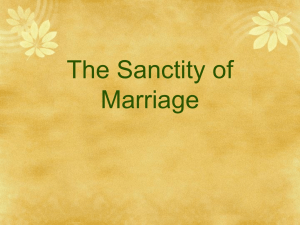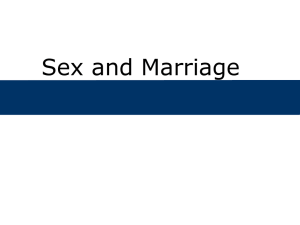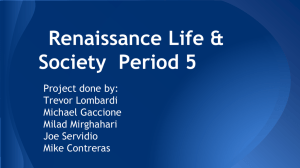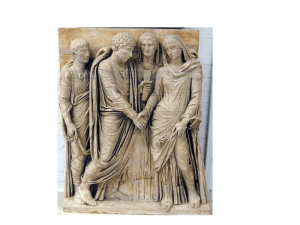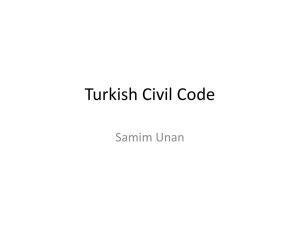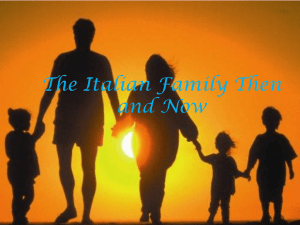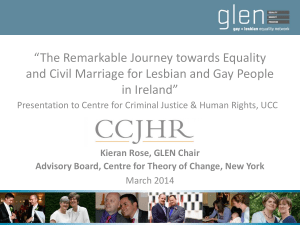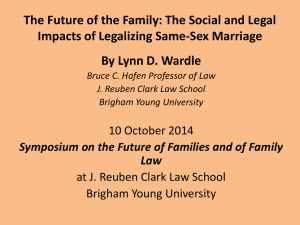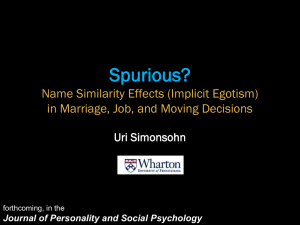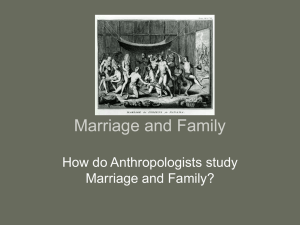Domestic Life
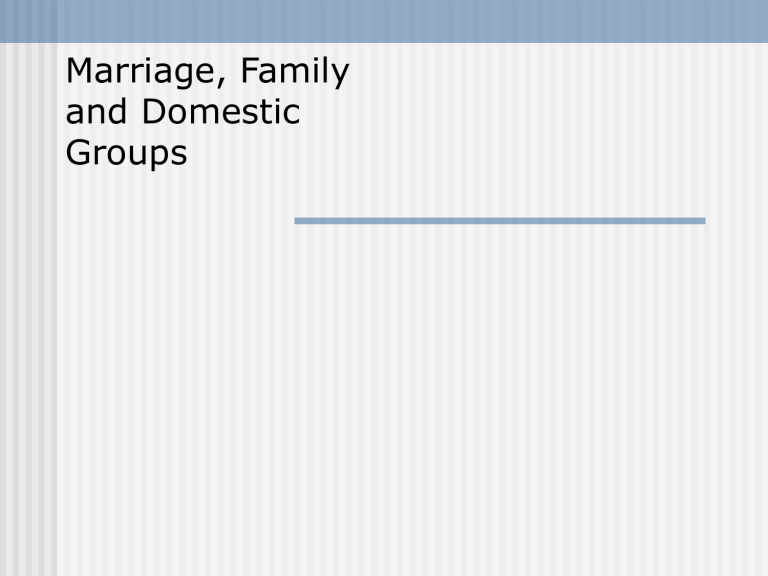
Marriage, Family and Domestic
Groups
Chapter Questions
What are some of the universal functions of marriage and the family?
What are some of the rule that regulate marriage in different societies?
How can these rules be explained?
Chapter Questions
How do arranged marriage and romantic love relate to the values of marriage and family in different societies?
What kinds of changes are taking place in the family in the United States?
How does a society’s subsistence strategy influence the shape of the family and the household?
Household Forms
Single-person
Nuclear
dominant in foraging and industrial cultures
Polygamous and Extended
dominant in horticultural, pastoral societies household may contain 50 members will decline with industrialization?
Nuclear Family
A husband, a wife, and their children.
High rates of divorce and remarriage create complicated kinship networks.
Composite Family
Aggregates of nuclear families linked by a common spouse.
Example: Polygynous household consisting of one man with several wives.
Extended Family
Blood relations extending over three or more generations.
Economic advantages: keeps land intact and provides security in times of crisis.
Provides a sense of participation and dignity for the older family members.
Households as Social Units
Spouse/Partner relationships
studies suggest marital satisfaction is strongly correlated to sexual activity
Sibling relationships
Domestic violence
Males as perpetrators, women as victims is found in all cultures
More common where men control wealth
Households in Social
Change
International immigration
challenges for parents and siblings
Shrinking households in the US
Increasing move away from nuclear households in industrialized cultures
Definitions of Marriage
Customs and obligations for the relationship between a sexually cohabiting adult male and female, between them and children they produce, and between their kin groups.
OR
A socially sanctioned form of heterosexual mating and co-residence establishing duties and obligations with respect to sex and reproduction; variant forms are homosexual mating and childless marriages.
Marriage Rules: Number of
Spouses
All societies have rules about how many spouses a person can have at one time.
Monogamy is the norm only in
Europe and north America.
75% of the world’s societies prefer plural marriage.
Basic Forms of Marriage
MONOGAMY: Marriage with one spouse exclusively and for life.
SERIAL MONOGAMY: Marriage with one spouse at a time but with remarriage after death or divorce.
POLYGAMY: Marriage with more than one spouse at a time.
Forms of Polygamy
Polygyny
A rule permitting a man to have more than one wife at a time.
Sororal polygyny
A form of polygyny in which a man marries sisters
Polyandry
A rule permitting a woman to have more than one husband at a time.
Fraternal polyandry
A custom whereby a woman marries a man and his brothers.
Functions of Marriage
Regulates sexual access.
Creates a family.
Expands social group.
Marriage
Customs, rules, and obligations for relationships between:
A sexually cohabiting man and woman
Parents and children
Families of the bride and groom
Marriage Regulates Sexual
Access
Reasons:
Limits sexual competition.
Provides stability for children.
Allows for stable economic exchange.
Marriage Establishes Family
Structures
Marriage provides a stable structure:
The male can provide food and protection.
The female can nurse and nurture the children.
Marriage Expands Social
Groups
Links different families and kin groups.
Leads to cooperation beyond the primary husband-wife pair.
Allows people to share resources.
Benefits the survival of the species.
A marriage is everyone’s business
Arranged marriage
The process by which senior family members exercise a great deal of control over the choice of their children’s spouses.
The obligations of a marriage encompass everyone in the extended family
These binding social and economic alliances are seldom left to chance, or to unmarried young people.
Marriage is the Economic and
Political Union of Two Families
Bride service
Work that the groom performs for his bride’s family for a variable length of time either before or after the marriage.
Bridewealth
Goods presented by the groom’s kin to the bride’s kin to legitimize a marriage.
Dowry
Presentation of goods by the bride’s kin to the family of the groom or to the couple.
Marriage Rules: Exogamy
Rules specifying that a person must marry outside a particular group.
Almost universal within the primary family group.
Leads to alliances between different families and groups.
Marriage Rules: Endogamy
Rules that marriage must be within a particular group.
In India, the caste is an endogamous group.
In the U.S., social classes tend to be endogamous.
Marriage Rules: Incest
Taboos
Prohibit sexual relations between relatives.
Universal to most cultures.
Exceptions :
Brother-sister marriages among royalty in ancient Egypt
Traditional Hawaiian society
Reasons for Incest Taboos
Avoids inbreeding.
Prevents disruption in the nuclear family.
Directs sexual desires outside the family.
Forces people to marry outside the family and create a larger social community.
Preferential Marriage Rules
Rules about the preferred categories of relatives for marriage partners:
Levirate
The custom whereby a man marries the widow of a deceased brother.
Sororate
When a man’s wife dies, her sister is given to him as a wife.
Primary Marriage Rights
Sexual access of husband and wife to each other.
Obligations by one or both parents to care for children born to the union.
Rights of husband and wife to the economic services of the other.
Divorce
Research suggests divorce rate is lower in unilineal descent cultures
Bilineal descent cultures have a more fluid system of joining and breaking up
In multi-spouse marriages, two wives are more stable than three or more
Gender affects ability to divorce
Widowhood and Remarriage
In some cultures, women’s position as a widow is often marked symbolically
modest clothes asexual little food intake
Remarriage is dependent on economic factors and gender expectations
Chapter 9, Marriage,
Family and Domestic
Groups
Key Terms
Exogamy
A rule specifying that a person must marry outside a particular group.
Endogamy
A rule prescribing that marriage must be within a particular group.
Cross cousins
The children of a parent’s siblings of the opposite sex. (mother’s brothers, father’s sisters)
Parallel cousins
The children of a parent's same-sex siblings. (mother’s sisters, father’s brothers)
Unilineal descent
A rule specifying that membership in a descent group is based on links through either the maternal or the paternal line; but not both.
Levirate
The custom whereby a man marries the widow of a deceased brother.
Sororate
The custom whereby, when a man’s wife dies, her sister is given to him as a wife.
Monogamy
A rule that permits a person to be married to only one spouse at a time.
Polygamy
A rule allowing more than one spouse.
Polygyny
A rule permitting a man to have more than one wife at a time.
Polyandry
A rule permitting a woman to have more than one husband at a time.
Soroal polygyny
A form of polygyny in which a man marries sisters.
Fraternal polyandry
A custom whereby a woman marries a man and his brothers.
Arranged marriage
The process by which senior family members exercise a great deal of control over the choice of their children’s spouses.
Bride service
Work that the groom performs for his bride’s family for a variable length of time either before or after the marriage.
Bridewealth
Goods presented by the groom’s kin to the bride’s kin to legitimize a marriage.
Dowry
Presentation of goods by the bride’s kin to the family of the groom or to the couple.
Nuclear family
The family organized around the relationship between husband and wife. A nuclear family consists of a husband, a wife, and their children.
Conjugal tie
The relationship between a husband and wife formed by marriage.
Extended family
Family based on blood relations extending over three or more generations.
Consanguineal
Related by birth.
Domestic group
A household unit, that usually, but not always, consists of members of a family.
Neolocal residence
System under which a couple establishes an independent household after marriage.
Composite (compound) family
An aggregate of nuclear families linked by a common spouse.
Patrilocal residence
System under which a bride lives with her husband’s family after marriage.
Patrilineage
A lineage formed by descent in the male line.
Matrilineage
A lineage formed by descent in the female line.
Matrilocal residence
System under which a husband lives with this wife's family after marriage.
Avunculocal residence
System under which a married couple lives with husband's mother’s brother.
Bilocal residence
System under which the married couple has the choice of living with the husband's or wife’s family.

